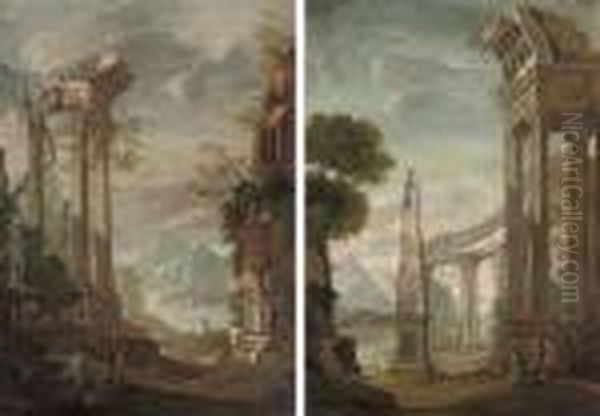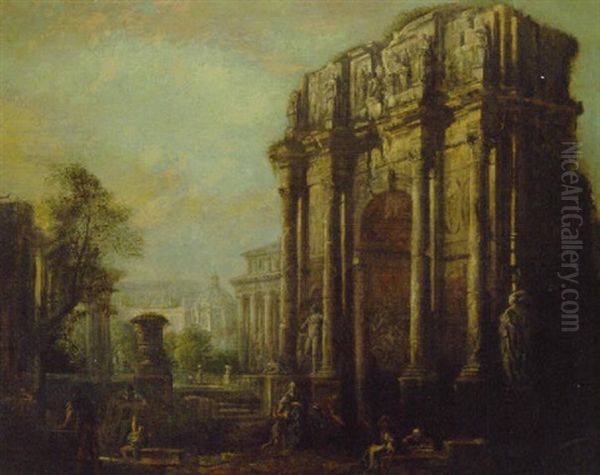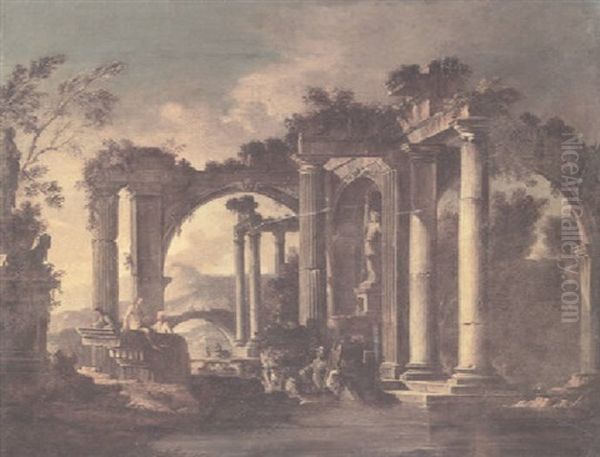Giovanni Ghisolfi stands as a significant figure in the landscape of 17th-century Italian Baroque art. Born in Milan in 1623 and passing away in the same city in 1683, his artistic career carved a distinct niche, particularly through his evocative depictions of architectural ruins and imaginative landscape scenes known as capricci. Though perhaps less universally known than some of his contemporaries, Ghisolfi's work demonstrates considerable skill and played a crucial role in the development of landscape and architectural painting as independent genres in Italy. His journey took him from his native Lombardy to the artistic heart of Rome, where he absorbed key influences that would shape his unique and enduring style.
Early Life and Artistic Formation in Milan
Giovanni Ghisolfi's life began in Milan in 1623. The artistic environment of Lombardy during this period provided the initial backdrop for his development. His foundational training in the art of painting came under the guidance of his uncle, Antonio Volpino. This early apprenticeship would have instilled in him the fundamental techniques and principles of design and composition prevalent at the time. While details of Volpino's own work are less prominent, this familial connection provided Ghisolfi with his entry point into the demanding world of artistic practice. Milan, a major cultural and economic center, offered exposure to various artistic currents, laying the groundwork for the young artist's future explorations.
This initial phase in Milan was crucial. It was here that Ghisolfi honed his basic skills and likely began to develop his visual sensibilities. The Lombard tradition, with its own distinct characteristics often emphasizing realism and careful observation, may have contributed to the meticulous detail later seen in his architectural renderings. His time spent learning from Antonio Volpino represents the essential starting point of a career that would eventually see him engage with some of the most influential artists of the Baroque era.
The Pivotal Journey to Rome

A defining moment in Ghisolfi's artistic development was his decision to travel to Rome. He undertook this significant journey not alone, but in the company of his friend, Antonio Busca, who was also pursuing a career as a painter. Rome, during the mid-17th century, was the undisputed epicenter of the art world, drawing artists from across Europe eager to study both the masterpieces of antiquity and the groundbreaking works of contemporary masters. For Ghisolfi and Busca, this move represented an opportunity to immerse themselves in a richer, more dynamic artistic environment than Milan could offer at that specific time.
Their primary goal in Rome was to deepen their artistic knowledge and refine their skills. The city offered unparalleled opportunities for study, from the ancient ruins scattered throughout its landscape to the powerful works being produced by leading Baroque artists. This Roman sojourn proved transformative for Ghisolfi, exposing him to influences that would profoundly shape his artistic direction and thematic preoccupations. The decision to travel with Antonio Busca also highlights the collaborative and communal nature of artistic education and development during this period.
Key Influences: Cortona and Rosa
While in Rome, Giovanni Ghisolfi came into contact with the work and, in some cases, the persons of several leading artists. Two figures stand out as particularly influential on his development: Pietro da Cortona and Salvator Rosa. Pietro da Cortona was a towering figure of the High Baroque, renowned for his dynamic compositions, rich color palettes, and large-scale fresco decorations. Studying Cortona's work exposed Ghisolfi to a powerful and dramatic mode of artistic expression, likely influencing his sense of composition and grandeur, even when applied to his preferred subjects of landscapes and ruins.
Salvator Rosa, on the other hand, was known for his romantic and often wild landscapes, stormy seascapes, and historical paintings, often imbued with a sense of drama and melancholy. Ghisolfi established a friendship with Rosa and even spent some time working in proximity to him. This connection was particularly significant. Rosa's influence can be seen not only in the atmospheric qualities of Ghisolfi's landscapes but also directly through collaboration, as Rosa reportedly painted figures into some of Ghisolfi's architectural scenes. The impact of these two distinct artistic personalities – the structured grandeur of Cortona and the romantic dynamism of Rosa – helped Ghisolfi forge his own unique synthesis.
The Art of the Capriccio: Ghisolfi's Signature Style

Giovanni Ghisolfi is perhaps best known for his mastery of the capriccio, a genre of painting featuring architectural fantasies. Capricci typically combine real, identifiable ancient ruins with imaginary structures or arrange existing monuments in novel, picturesque combinations, often populated by small figures. Ghisolfi excelled in this genre, becoming recognized as one of its earliest and most important proponents in Italy. His capricci are characterized by a meticulous attention to architectural detail, a sophisticated understanding of perspective, and a dramatic use of light and shadow (chiaroscuro) to create evocative moods.
His paintings often depict crumbling Roman temples, arches, and colonnades, bathed in a luminous, sometimes melancholic light. These scenes are not mere topographical records; they are imaginative reconstructions that reflect a Baroque fascination with antiquity, transience, and the picturesque decay of former grandeur. Ghisolfi's ability to blend archaeological accuracy (or the appearance of it) with artistic invention set his work apart. He demonstrated a remarkable skill in composing these complex scenes, balancing architectural masses with open spaces and integrating small figures that add scale and sometimes narrative interest. This focus on architectural ruins and fantasy landscapes became his defining contribution.
Representative Works: Visions of Antiquity
Among Giovanni Ghisolfi's notable works, specific titles help illustrate his artistic preoccupations. Capriccio architettico con figure (Architectural Capriccio with Figures) is a title representative of his core output. Such works typically showcase his skill in rendering complex classical architecture, often in a state of ruin, arranged imaginatively. The inclusion of 'figure' (figures) points to the small-scale human elements often present in his scenes, which serve to animate the architectural setting and provide a sense of scale, emphasizing the monumentality of the ruins. These figures might be depicted as contemporary observers, historical characters, or allegorical personages.
Another mentioned work, Paesaggio con San Giovanni Battista (Landscape with Saint John the Baptist), demonstrates his ability to integrate religious or historical narratives within his characteristic landscape settings. Placing a figure like Saint John the Baptist amidst classical ruins or in a specific type of landscape adds a layer of meaning, perhaps contrasting the Christian narrative with the remnants of the pagan past, or using the evocative setting to enhance the spiritual or contemplative mood associated with the saint. These works exemplify Ghisolfi's command of composition, his handling of light, and his unique blend of landscape, architecture, and sometimes narrative elements. It is worth noting, however, that the passage of time has affected the condition of some works, with reports of damage and later repainting impacting pieces like Capriccio architettico con figure.
Collaborations and Artistic Relationships

Ghisolfi's career was marked by interaction and collaboration with several contemporary artists, reflecting the interconnected nature of the Baroque art world. His relationship with Salvator Rosa was particularly significant. Beyond the influence Rosa exerted, the two artists actively collaborated, with Rosa adding figures to Ghisolfi's architectural compositions. This practice, while common, sometimes leads to art historical discussions regarding attribution, questioning the precise division of labor in certain works. Despite these potential ambiguities, the synergy between Rosa's dynamic figures and Ghisolfi's structured settings likely produced compelling results.
His friendship and travels with Antonio Busca also led to direct collaboration. Together, they worked on fresco decorations, notably at the Certosa di Pavia, where they both studied the works of Pietro da Cortona and contributed to the decorative scheme. Ghisolfi is documented as having painted frescoes depicting scenes from the life of Saint Benedict and an image of Saint Bruno there. Further collaborative work with Busca occurred at the Palazzo Borromeo Arese in Cesano Maderno, near Milan, involving decorative frescoes. These projects demonstrate Ghisolfi's versatility beyond easel painting and his ability to work effectively within larger decorative programs alongside other artists.
Further Collaborations and Connections
Ghisolfi's collaborative activities extended to other projects and artists as well. At the Villa Litta in Varese, he participated in a decorative project alongside Federico Bagni and Giovanni Battista Bidelli. This engagement further underscores his activity within the Lombard artistic milieu, particularly in the decoration of prestigious residences. Working on such large-scale decorative schemes required coordination and a shared aesthetic vision among the participating artists.
His family connections also played a role in his artistic life. His brother, Filippo Ghisolfi, was also a painter. While details are scarce, the provided information suggests they may have collaborated on works related to military art in Milan. This hints at a possible family workshop structure or at least shared professional interests, common in artistic families of the period. These various collaborations – with major figures like Rosa, close friends like Busca, project partners like Bagni and Bidelli, and potentially family members like Filippo – paint a picture of an artist actively engaged within his professional community.
Influence on Later Artists: Panini and Locatelli
Giovanni Ghisolfi's pioneering work in the realm of architectural capricci and ruin landscapes had a discernible impact on subsequent generations of artists. One of the most notable figures influenced by Ghisolfi was Giovanni Paolo Panini (or Pannini). Panini, who became a leading painter of Roman views (vedute) and capricci in the 18th century, is said to have acknowledged Ghisolfi's influence. Ghisolfi's compositions, his way of organizing architectural elements, and his atmospheric treatment of ruins provided a foundation upon which Panini and others would build. Ghisolfi's work helped establish the capriccio as a popular and respected genre.
Another artist whose work shows an affinity with Ghisolfi's, likely through indirect influence and shared artistic currents, is Andrea Locatelli. Locatelli, also active in the later Baroque and Rococo periods, specialized in landscapes. The provided sources suggest Locatelli was influenced by the tradition Ghisolfi worked within, a tradition also shaped by Salvator Rosa. Furthermore, the mention of the Dutch painter Jacob de Heusch in connection with Locatelli and the development of Italian landscape painting highlights the complex web of influences crossing national boundaries during this era. Ghisolfi's role as an early specialist in architectural landscapes thus positions him as an important precursor to the flourishing of veduta and capriccio painting in the following century.
Anecdotes, Challenges, and Legacy
Like many artists, Ghisolfi's career and posthumous reputation have encountered certain complexities. The close collaboration with Salvator Rosa, while fruitful, has led to scholarly debate regarding the precise authorship of certain works, a common challenge when dealing with workshop practices and partnerships of the era. This highlights the difficulty in definitively assigning every brushstroke in collaborative environments.
Furthermore, the physical condition of some of Ghisolfi's paintings presents challenges for contemporary appreciation and study. Reports of significant damage due to aging, decay, or potentially heavy-handed restoration efforts on key works like Capriccio architettónico con figure mean that viewers today may not be seeing these paintings exactly as Ghisolfi intended. This loss of original surface and detail can hinder a full understanding of his technique and artistic vision.
Despite his achievements and influence, Ghisolfi's recognition arguably faded somewhat after his death, overshadowed perhaps by later masters of the veduta and capriccio. It was largely through the efforts of art historians in the 20th century that his work was re-evaluated and his significant contribution to the development of landscape and architectural painting was more fully acknowledged. His reputation today rests on his skill as a painter of evocative architectural fantasies and his important role as a pioneer in this specialized genre.
Conclusion: Ghisolfi's Enduring Contribution
Giovanni Ghisolfi (1623-1683) occupies a vital place in the history of Italian Baroque art. Emerging from Milan and profoundly shaped by his experiences in Rome, particularly his engagement with the works of Pietro da Cortona and his collaboration with Salvator Rosa, he developed a distinctive artistic voice. His specialization in architectural capricci and landscapes featuring classical ruins marked him as an innovator, contributing significantly to the establishment of these genres as independent fields of artistic endeavor.
His meticulous rendering of architecture, combined with an imaginative approach to composition and an atmospheric use of light, created compelling visions of antiquity filtered through a Baroque sensibility. Works like Capriccio architettico con figure exemplify his mastery of this form. Through collaborations with artists such as Antonio Busca, Federico Bagni, and Giovanni Battista Bidelli, and his influence on later painters like Giovanni Paolo Panini and Andrea Locatelli, Ghisolfi's impact extended beyond his individual canvases. Despite challenges related to attribution and conservation, Giovanni Ghisolfi is rightly recognized today as a master of the architectural fantasy and a key figure in the evolution of Italian landscape painting.